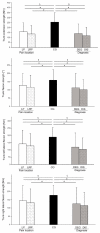Physical Abilities in Low Back Pain Patients: A Cross-Sectional Study with Exploratory Comparison of Patient Subgroups
- PMID: 33802214
- PMCID: PMC8000067
- DOI: 10.3390/life11030226
Physical Abilities in Low Back Pain Patients: A Cross-Sectional Study with Exploratory Comparison of Patient Subgroups
Abstract
An abundance of literature has investigated the association between low back pain (LBP) and physical ability or function. It has been shown that LBP patients display reduced range of motion, decreased balance ability, impaired proprioception, and lower strength compared to asymptomatic persons. The aim of this study was to investigate the differences between LBP patients and healthy controls in terms of several physical abilities. Based on the premised that different biomechanical and physiological causes and consequences could be related to different types of LBP, a secondary exploratory attempt of the study was to examine the differences between LBP subgroups based on the pain location (local or referred) or type of pathology (discogenic or degenerative) on the level of impairment of function and ability. Participants performed range of motion tests, trunk maximal voluntary contraction force tests, a sitting balance assessment, the timed up-and-go test, the chair rise test, and the trunk reposition error test. Compared to the control group, symptomatic patients on average showed 45.7% lower trunk extension (p < 0.001, η2 = 0.33) and 27.7 % lower trunk flexion force (p < 0.001, η2 = 0.37) during maximal voluntary contraction. LBP patients exhibited decreased sitting balance ability and lower scores in mobility tests (all p < 0.001). There were no differences between groups in Schober's test and trunk repositioning error (p > 0.05). No differences were observed among the LBP subgroups. The exploratory analyses are limited by the sample size and uncertain validity of the diagnostic procedures within this study. Further studies with appropriate diagnostic procedures and perhaps a different subgrouping of the LBP patients are needed to elucidate if different types of LBP are related to altered biomechanics, physiology, and function.
Keywords: biomechanics; degeneration; discogenic pain; flexibility; function; low back pain; mobility; radiated pain; strength.
Conflict of interest statement
The authors declare no conflict of interest.
Figures



Similar articles
-
Comparison of the lumbar flexion angle and repositioning error during lumbar flexion-extension in young computer workers in Korea with differing back pain.Work. 2015 Jun 5;51(2):223-8. doi: 10.3233/WOR-141856. Work. 2015. PMID: 24763344
-
The association of low back pain, neuromuscular imbalance, and trunk extension strength in athletes.Spine J. 2006 Nov-Dec;6(6):673-83. doi: 10.1016/j.spinee.2006.03.012. Spine J. 2006. PMID: 17088198
-
Effects of pelvic asymmetry and low back pain on trunk kinematics during sitting: a comparison with standing.Spine (Phila Pa 1976). 2006 Mar 1;31(5):E135-43. doi: 10.1097/01.brs.0000201325.89493.5f. Spine (Phila Pa 1976). 2006. PMID: 16508537
-
Altered patterns of superficial trunk muscle activation during sitting in nonspecific chronic low back pain patients: importance of subclassification.Spine (Phila Pa 1976). 2006 Aug 1;31(17):2017-23. doi: 10.1097/01.brs.0000228728.11076.82. Spine (Phila Pa 1976). 2006. PMID: 16924221
-
Kinematic Characteristics of Sit-to-Stand Movements in Patients With Low Back Pain: A Systematic Review.J Manipulative Physiol Ther. 2019 Sep;42(7):532-540. doi: 10.1016/j.jmpt.2018.12.004. J Manipulative Physiol Ther. 2019. PMID: 31864436
Cited by
-
Biomechanical Phenotyping of Chronic Low Back Pain: Protocol for BACPAC.Pain Med. 2023 Aug 4;24(Suppl 1):S48-S60. doi: 10.1093/pm/pnac163. Pain Med. 2023. PMID: 36315101 Free PMC article.
-
The cross-cultural adaptation, validity, and reliability of the Spanish version of the Fremantle Back Awareness Questionnaire.Front Psychol. 2023 Mar 2;14:1070411. doi: 10.3389/fpsyg.2023.1070411. eCollection 2023. Front Psychol. 2023. PMID: 36935999 Free PMC article.
References
Grants and funding
LinkOut - more resources
Full Text Sources
Other Literature Sources
Miscellaneous

